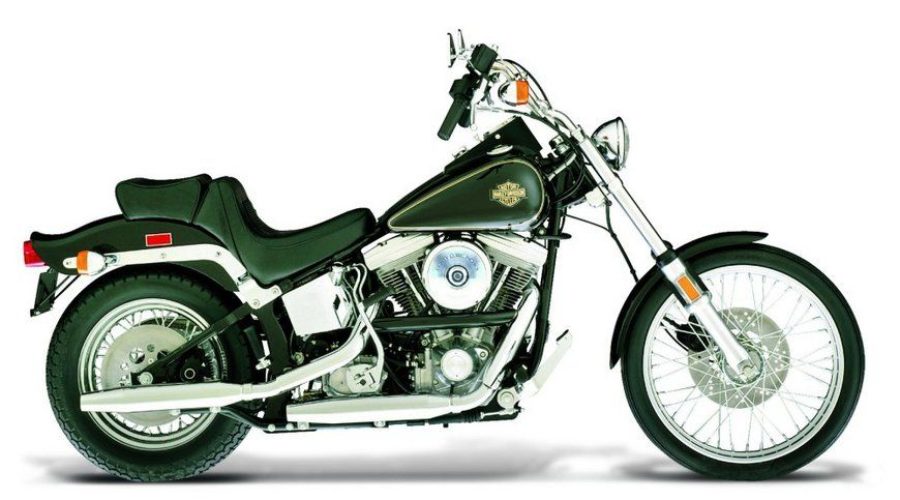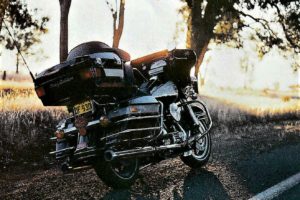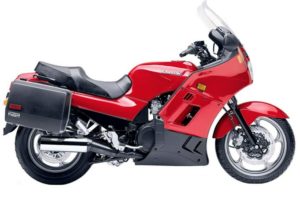1984 Harley-Davidson FXST Softail
It has been said that every man alive, from dunny cleaner to High Court judge, has at some stage in his life dreamed of rolling down the road on a Harley Davidson. The FXST Softail is probably the model in the fantasy.
Most of us will recall that poster which adorned a million walls in the late Sixties; the one of Peter Fonda and Dennis Hopper, taken from Easy Rider, as they cruised over a bridge on their Harleys, heading for a grim, miserable death.
The look on their faces, and their stretched out, slung back riding style, suggested a type of riding experience which is very rare today. There was no hint of knees dragging on the road, tachos in the five figure region, or the intense concentration which riding a modern sports bike demands. Fonda and Hopper were taking it easy.
There aren’t many bikes which you can ride like this these days and be satisfied. We’re living in the kingdom of the great god called performance, and he has planted the notion in our brains, (assisted by most of the motorcycle manufacturers) that our riding pleasure is directly proportional to the amount of power we have at our disposal. We seem to have accepted this doctrine as the way things are supposed to be.
However, there are some heretics among the masses, those who can look at that poster and say “Well, yeah. That’s what I’m looking for in a bike.” If you are one such person, then Harley-Davidson has the bike for you; the 1984 FXST Softail.

Harley-Davidson has never concentrated on engine development and technological sophistication in the sense that these factors are its products’ chief selling points and image makers in the marketplace. However, last year the company was facing disaster, partly because it had neglected these areas and, in the face of Japanese clones sporting a higher level of refinement at a much lower price, had resolutely maintained that patriotism would pull it through.
This noble attitude unfortunately didn’t count for much on the company balance sheet, and H-D realised that its 45 degree V-twins were in need of a major update if they were not to become relics of the Easy Rider age. Aided by a five-year tariff protection plan, which initially lifted the price of over-700 cm3 Japanese machines to within $1000 of its bikes in the USA, H-D made some big changes to its flagship 1340 cm3 fleet for 1984.
The major area of attention has been the motor. The Softail, in common with the FXRS Low Glide which we tested in May, has the new V2 Evolution unit which boasts different cylinder construction, stronger conrods, flat-topped pistons, a new cylinder head (which follows the “Knucklehead”, “Panhead” and “Shovelhead” and has picked up the nickname “The Blockhead”), with redesigned camshafts, a narrower valve angle, and a smaller combustion chamber.
There’s also a revised bottom end incorporating a balancer on the end of the crankshaft. It is claimed to be oiltight, and to produce 10 percent more power and 15 percent more torque – 45 kW at 5000 rpm and 111.8 Nm at 3400 rpm to be precise.

While the other bikes in the H-D range still have conventional twin spring/damper units on the rear, the Softail has a setup which has not been seen before on any production motorcycle. The new rear suspension system exemplifies what the factory has tried to achieve with this bike.
It has used modern technology, not only to improve the ability of the machine, but to also rekindle memories of an era when Harley Davidson was king of the American motorcycle scene.
The system uses two gas-charged spring/damper units, mounted side by side, lying horizontally underneath the gearbox. They are thus out of sight. The eye sees only the huge triangulated swinging arm which has been designed to give the bike a hardtail look, just like the Harleys of the Fifties. It’s almost as though the engineers said “OK, we’ve got to go techno to improve things, but we’ll make damn sure we hide the gizmos behind the image.”
The image is custom, and the Softail has the heaviest dose we’ve seen. A (dare we say it) chopper-look front end, Fat Bob fuel tank, highway pegs and foot controls, horseshoe oil tank, the lowest seat in the business, and enough chrome to make you squint in the sunlight all combine with the hardtail effect to give the bike the individuality which the custom label implies.
You climb into the Softail in the manner of Norm settling into his favourite armchair to watch Wide World of Sports on a Saturday afternoon. It’s instant relaxation. Hitting the starter button. (If you want to go the whole hog (sorry ’bout that!) with the image bit and use the kickstarter you would be advised to have a large meal first) sees the starter motor take the strain, hesitate momentarily, then roll the motor over. When warm the Softail starts first time; in the morning the same applies with the tank-mounted choke fully on and a couple of twists of the throttle. After 15 seconds or so the choke can be shut off and the motor will rumble away merrily; another 30 seconds and you’re ready to go.
The dry, multiplate clutch is much lighter in action than previous units but still requires more effort than any Japanese device. First gear engages smoothly when the bike is cold, and until you’re used to the highway pegs, the first couple of hundred metres are accompanied by a series of fancy dance steps as you frantically grope around for something to rest your feet on.

Once accustomed to the pegs, the riding position in general is great for city and suburban punting. You’re not hunched over the tank, hanging on to the clip-ons with your feet tucked up beneath you. Instead, you are sitting upright on a bike with a low centre of gravity, and your backside is only 640 mm from the ground. You are also at ease – a good frame of mind to be in when riding in traffic.
However the Softail’s rather, ahem, portly dimensions means that ’round-town manoeuvrability is not one of its greatest assets.
A dry weight of 281 kg and a wheelbase of 1676 mm will definitely not see many couriers on this bike, but it encourages such a leisurely riding style that nipping through lines of cars is not really something you care to bother yourself with.
The four-speed gearbox is clunky when warm, so a deliberate flick of the left boot is needed with each change. Second and third gears are pretty well adequate for the inner city, while fourth at 60 km/h is the most lazy combination in motorcycledom for showing off in suburbia, and there’s a pile of torque available if you want to enjoy the incredible sensation of the big V-twin picking up steam.
Big boots an advantage
While the highway pegs are great for cruising, their relationship to the gearchange and brake levers is not good. When changing up, people with a shoe size under 15 will have to raise their entire left leg to make contact. Similarly, it is impossible to change down without lifting your foot from the peg. It’s a hassle until you get used to it, and even then, on both sides, the foot controls’ clumsy positioning could lead to big problems in an emergency. It’s fortunate that changing gear is not something you need to do too often, so apart from this problem the Softail scores very well as a town bike.

Of course if you’re into looking at your reflection in shop windows and watching people watching you, your first ride to work will see you miss starting time, lunchtime, and knock off time as you merrily ride up and down the main drag until you run out of petrol. If you tend towards paranoia any time you’re the centre of attention don’t even test ride the Softail – you’ll be a wreck after five minutes.
The raked-out front end looks very unconventional, but in specification it’s as traditional as they come. The large and long telescopic forks don’t have any of the currently de rigeur antidive or air assistance, and they support a 21-inch spoked wheel. Pardon me, sire. Did you say “a 21-inch front wheel?” Yep. Two rubber mounted stanchions, anchored to the top triple clamp, support the high riser handlebars, while the lower triple clamp acts as a mount for the headlight.
The frame is a conventional double cradle tubular steel structure, apart from the modifications which have been made to accommodate the rear suspension. These consist of wide steel brackets linking the upper and lower frame rails which also act as the swinging arm mounts, and a bracket beneath the two lower cradles which serves as the forward anchoring point for the spring/damper units.
The frame is very strong, and its rear-end modifications achieve the desired deceptive effect. The bike looks like it has no rear suspension because you can’t see the pivot, and the upper and lower frame rails seem to flow straight into the swinging arm. As the brochure says, its “a giant step backward in custom styling”.

A giant step forward is the front brake. A single piston caliper with a drilled 290 mm disc is situated on the left side of the wheel, and while it requires a decent heave on the lever the effort is rewarded with far better power and feel than previous Harley front brakes. The rear brake has the same single piston fixed caliper as last year’s FX series models, and a 290 mm undrilled disc. Like the front brake, it responds well to a decent push, and is very controllable.
I found this out on the Bells Line of Road near Sydney, when rounding a blind corner I was confronted by a car which had stopped in the middle of the lane waiting to do a U-turn, and a line of traffic coming the other way. There was no chance of stopping in time, so it was a case of braking hard and hoping that the brakes would resist locking up and thus allow the bike to be steered between our friend and the opposing traffic. The rear wheel locked up momentarily, but thanks to the excellent feedback that heavy-handed brakes such as these provide, the Softail and yours truly escaped becoming decorations on the back of this “gentleman’s” Statesman.
This incident occured on a trip to Lightning Ridge. The laid back style of the Softail which makes riding it in the city such a pleasure promised that open road cruising would do wonderful things for a journalist’s frenzied state of mind. As it turned out the trip lived up to expectations, and proved that bullet like speeds and the relentless pushing of mind and body are not essential if you wish to cover reasonable distances in a day.

The Softail feels most content at 90-110km/h. The low frequency vibration is more of an unstressed rumble, but the Softail does shake more than the FXRS Low Glide, which has its engine rubber-mounted in the frame. Push the speedo up towards 120 km/h, and the vibration becomes more pronounced; above this speed it becomes hard to live with. The bike will run to 175 km/h, but you’re on the wrong brand if you want to ride at this sort of speed. Your teeth will fall out pretty quickly, too.
The immense torque of the V-twin means that changing down from fourth gear on the highway is largely unnecessary. The Softail will pull top gear up the steepest hills, and it is only when this type of country is accompanied by sharp corners that the gearbox is used.
The bike accelerates well from highway speeds. Twisting the throttle sees the motor wind up with a couple of thumps and then the big Harley picks up its skirts and does the job of overtaking very respectably indeed. Under acceleration, you are always conscious that you are riding a MOTORcycle; the sensation of being propelled along by an anonymous power generating device which you can’t feel working is not a part of the Harley experience.
While the trick rear suspension succeeds brilliantly in creating an image, it also does its job. As we mentioned before, the two spring/damper units are mounted horizontally beneath the gearbox. Each has its own remote fluid reservoir, and is nitrogen-charged at a pressure of 100 kPa to ensure the smooth transfer of damping fluid as the piston moves. The piston is drawn out of the shock absorber body under load, rather than pushed into it as on conventional systems.
The setup has much more compliance than conventional Harley rear suspension. There are some long rough sections of bitumen on the way to Lightning Ridge, but the damping didn’t fade and the shocks coped with most obstacles while still providing a very plush ride.
However whoop-style bumps with a sharp front edge cause the system to bottom out, even at low speeds, and because of the upright seating position the old back really cops it.

The front forks have enough travel to put a motocrosser to shame, while the spring rate and damping are ideally suited to the performance of the machine. At 90-110 km/h the damping is well controlled and the springs are firm enough to keep the front wheel tracking accurately in the rough without being harsh on smaller ripple-style sections of road.
Looking at the Softail you would imagine that handling is not one of its strong points, and indeed any Japanese machine over 125 cm3 will leave it for dead on a tight winding road. Charge too hard into a low speed corner and you’ll find yourself changing direction much less radically than you anticipated, due to the lack of cornering clearance.
The slow steering certainly doesn’t promote quick changes of direction, although it is not as heavy as you would expect thanks to the skinny front tyre, and with 36 degrees of rake the bike has rock solid straight line stability.
If the Softail is ridden in the way its maker intended, it handles very predictably and is great fun to ride on smooth sweeping roads such as Bells. You lean back, relax, and hold a constant 100-110 km/h while the big bomber hauls its bulk from side to side with a smooth, graceful ease matched only by the way the motor eats up what seem to be several kilometres with each stroke.
At these speeds on rougher roads bumps and potholes hit mid-corner are virtually ignored by the front end. That 21-inch wheel rolls over or through anything without being deflected off course. The rear end will wallow in rough corners at speeds over 110 km/h, and as we mentioned before, small dips with a sharp front edge will cause the suspension to bottom, but the bike simply soldiers on.
The Softail’s most comfortable territory though is the open plain and the long straight road. On most other machines several hundred kilometres of this would bore you witless, but on the big Harley the lazy rhythm of the motor, the comfortable seat, and the fact that you’re sitting up looking at the world, is a great mind-expanding combination. You just can’t be bothered with mundane thoughts such as “How fast am I going?” and “When will I get there?” Instead, the old brain and body are lulled into a real “hang loose” state, and you’re free to drift from pleasant thought to even more pleasant thought.
You arrive at your destination feeling better than when you started, and a whole lot better than if you had just averaged 140 km/h on a four-cylinder superbike over the same distance. The strange thing is that the 700 km to Lightning Ridge seemed to take much less time to cover. As the saying goes “Time flies … “
At a current price of slightly over $10,000, not even the most one-eyed Harley owner could deny that Japanese machines offer, for half this sum, much more sophistication, technology and performance per dollar than the Softail. But the bike has a quality of finish and a ruggedness of construction that make it a realistic lifetime proposition, and if what the health freaks say about stress causing an early death is true, the Softail owner will live a long and happy life indeed.
By Bill McKinnon. Two Wheels, September 1984





